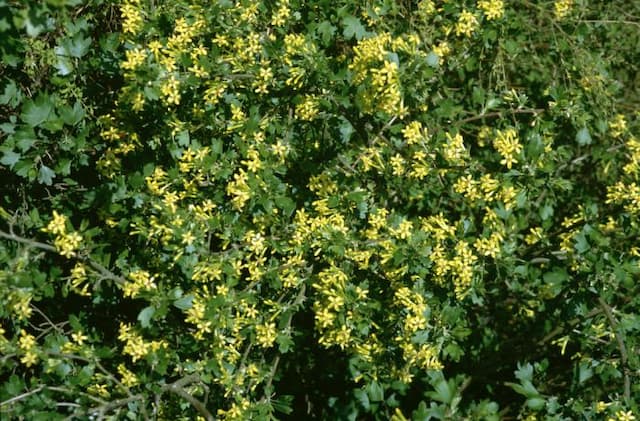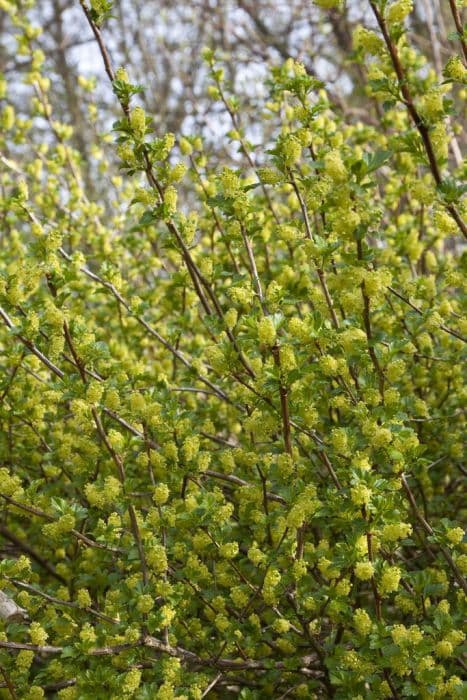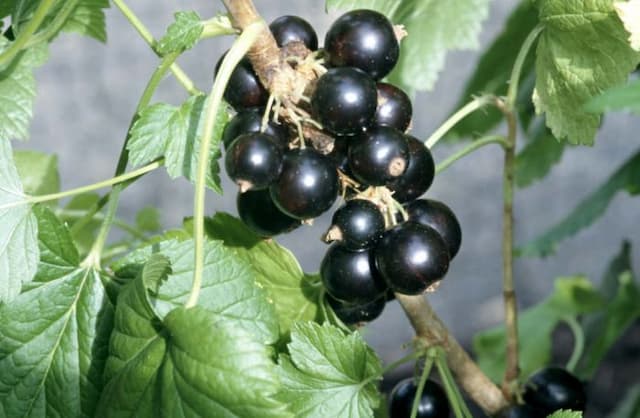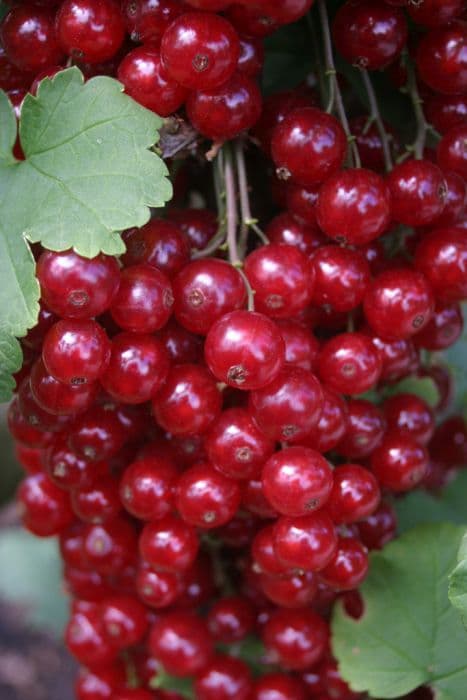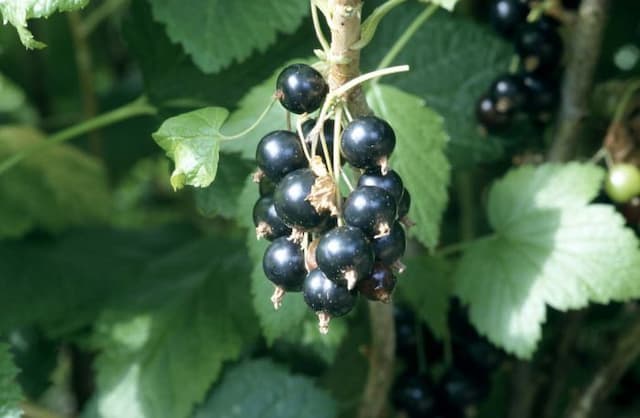Red currant Ribes rubrum

ABOUT
The commonly known red currant bush is characterized by its distinctive features. The plant boasts multiple stems that grow directly from the base, creating a lush, bushy appearance. The leaves of the red currant are three to five lobed, with a bright green color on top and a paler shade underneath. Each leaf exhibits a serrated edge that adds to the plant's texture. During the flowering season, the red currant produces clusters of small, inconspicuous flowers. These flowers are usually a creamy white color and dangle in strings from the branches. As the season progresses, the flowers give way to the plant's namesake fruits – the red currants. These berries are typically bright red and translucent, with a shiny skin that encases the juicy flesh within. They are generally smaller in size and grow in striking, pendulous clusters that can dangle from the branches. The fruit not only adds a splash of vibrant color to the landscape but also attracts various birds and wildlife, contributing to the plant's natural charm. The appearance of the red currant is lively and decorative, making it a popular choice for both edible and ornamental purposes in gardens.
About this plant
 Names
NamesFamily
Grossulariaceae.
Synonyms
Red Currant, Redcurrant, Garden Currant, European Red Currant.
Common names
Ribesium rubrum, Grossularia rubra, Ribes silvestre, Ribes spicatum, Ribes vulgare, Ribes sativum
 Toxicity
ToxicityTo humans
Red currant (Ribes rubrum) is not toxic to humans. In fact, both the berries and the leaves of red currants are edible, with the berries being commonly consumed raw or used in various recipes. They are considered safe to eat and are not associated with poisoning or toxic consequences when consumed as a food item.
To pets
Red currant (Ribes rubrum) is also considered safe for most pets, including dogs and cats. The plant is not typically associated with toxicity, and pets can often consume the berries without experiencing adverse effects. However, individual animals may have sensitivities or allergies, so it is always advisable to introduce any new food in moderation and monitor for any unusual reactions.
 Characteristics
CharacteristicsLife cycle
Perennials
Foliage type
Deciduous
Color of leaves
Green
Flower color
Greenish-white
Height
3-5 feet (0.9-1.5 meters)
Spread
3-5 feet (0.9-1.5 meters)
Plant type
Shrub
Hardiness zones
3-8
Native area
Europe
Benefits
 General Benefits
General Benefits- Edible Fruit: Ribes rubrum, commonly known as red currant, produces berries that are tart and flavorful, popular in jams, jellies, and desserts.
- Nutritious: The fruit of the red currant is high in vitamin C and other antioxidants, beneficial for general well-being and nutrition.
- Wildlife Attraction: Red currant plants can attract birds and beneficial insects to your garden, which helps with pollination and natural pest control.
- Landscape Aesthetics: Red currants have attractive foliage and can bear brightly colored fruit which enhances the visual appeal of landscapes and gardens.
- Culinary Versatility: The fruit from red currant plants is versatile and can be used in a wide range of culinary dishes, from savory to sweet.
- Relatively Easy to Grow: Red currants are hardy shrubs that can be easier to care for than some other fruit-bearing plants, making them a good choice for novice gardeners.
- Compact Growth: As these plants are relatively small, they are suitable for gardens where space is limited, and they can even be grown in containers.
- Cultural Significance: Red currant has a long history of cultivation and is featured in various traditional recipes, contributing to cultural culinary heritage.
- Potential Economic Value: Red currants can be commercially cultivated, providing income through the sale of fresh berries, plants, or value-added products like preserves.
 Medical Properties
Medical Properties- Antioxidant activity: Ribes rubrum berries are rich in vitamin C and anthocyanins, which are known for their antioxidant properties.
- Anti-inflammatory effects: The plant has been associated with reducing inflammation due to the presence of flavonoids.
- Diuretic properties: Traditional use suggests that Ribes rubrum may promote urine production, helping in the elimination of bodily fluids.
- Supporting immune system: Due to its high vitamin C content, it may aid in supporting the immune system.
- Gastroprotective effects: There is some evidence to suggest that the plant has protective effects on the gastrointestinal system.
- Cardiovascular health: The antioxidants in Ribes rubrum may contribute to cardiovascular health by preventing the oxidation of LDL cholesterol.
 Air-purifying Qualities
Air-purifying QualitiesThis plant is not specifically known for air purifying qualities.
 Other Uses
Other Uses- Dye Production: The fruits of red currant can be used to produce natural dyes, suitable for coloring fabrics and yarns.
- Insect Repellant: The strong aromatic leaves can be rubbed on the skin to help repel mosquitoes and other insects.
- Culinary Acidifier: Red currant juice can act as an acidifying agent in recipes, offering a tart flavor to balance sweetness.
- Photography: In historical processes, red currant juice was sometimes used in the production of photosensitive chemicals for early photography.
- Bird Habitat: The bushes of red currants can provide shelter and nesting opportunities for birds in the garden.
- Floral Arrangements: Although not often used, the bright berries and foliage of red currant can add a natural charm to floral decorations.
- Companion Planting: Red currants can be planted alongside other garden crops to attract beneficial insects and aid in pollination.
- Soil Indicator: The presence of red currant in the wild can indicate certain soil conditions, such as moisture level and pH, useful for ecological surveying.
- Fish Bait: Some anglers use red currant berries as bait due to their vibrant color and size, which can attract certain species of fish.
- Environmental Education: Red currant plants can be used as a teaching tool for children and students to learn about the lifecycle of plants and the importance of fruit-bearing shrubs in an ecosystem.
Interesting Facts
 Feng Shui
Feng ShuiThe red currant is not used in Feng Shui practice.
 Zodiac Sign Compitability
Zodiac Sign CompitabilityThe red currant is not used in astrology practice.
 Plant Symbolism
Plant Symbolism- Vitality and Vigor: The Ribes rubrum, commonly known as red currant, bears bright and vibrant red berries that symbolize an energetic and lively spirit.
- Prosperity and Abundance: As red currant plants can produce a plentiful harvest, they are often associated with wealth and the idea of having an abundance of resources or successes.
- Sweetness of Life: The berries of the red currant plant are sweet with a slightly tart flavor, representing the complexity and richness of life's experiences.
- Healing and Nourishment: Red currants have been used for their medicinal properties as a source of nutrients and antioxidants, symbolizing health and rejuvenation.
 Water
WaterRed currant plants require consistent moisture, especially during the growing season. They should be watered deeply once a week with about 1 to 1.5 gallons of water per plant, depending on the weather conditions. During periods of drought or extreme heat, watering frequency may need to increase to twice a week. It's important to avoid overhead watering to prevent foliar diseases, so use a soaker hose or water at the base of the plants. Over-watering should be avoided as it can lead to root rot, but the soil should remain evenly moist.
 Light
LightRed currants thrive in full to partial sunlight. They perform best with a minimum of 6 hours of direct sunlight per day but can tolerate some shade, particularly in hotter climates where afternoon shade can protect them from excessive heat. An ideal spot would be one that gets ample morning light and protection from the intense late afternoon sun.
 Temperature
TemperatureRed currants grow well in a wide range of temperatures but prefer cooler conditions. They are hardy and can survive winter temperatures as low as -40°F, making them suitable for many temperate regions. The ideal growing temperature for red currants is between 55°F and 75°F. They can tolerate brief temperature extremes outside this range, but prolonged heat or frost may affect plant health and fruit production.
 Pruning
PruningPruning red currants is essential for maintaining plant health and encouraging fruit production. Pruning should be done in late winter or early spring when the plant is dormant. Remove any dead or diseased wood, thin out crowded areas to improve air circulation, and cut back older stems to promote new growth. Prune about one-third of the oldest branches each year to rejuvenate the plant.
 Cleaning
CleaningAs needed
 Soil
SoilRed currant (Ribes rubrum) thrives in well-drained, loamy soil rich in organic matter with a pH between 6.0 and 6.5. Creating the best soil mix for red currant involves adding compost or well-rotted manure to improve fertility and structure. A combination of two parts garden soil, one part compost or peat, and one part sand or perlite provides a suitable growing medium for red currants.
 Repotting
RepottingRed currants (Ribes rubrum) do not require frequent repotting as they are typically grown outdoors in the ground. If grown in containers, young red currant plants may need repotting every 2-3 years to provide fresh soil and additional space for growing roots. Mature plants can be top-dressed with fresh compost instead of repotting.
 Humidity & Misting
Humidity & MistingRed currant (Ribes rubrum) plants prefer moderate humidity levels and can tolerate a range of atmospheric moisture conditions. They do not have specific humidity requirements, but ensuring good air circulation around the plants helps prevent fungal diseases which can be favored by high humidity.
 Suitable locations
Suitable locationsIndoor
Place red currant in bright light with cool temperatures.
Outdoor
Plant in sunny spot, provide well-draining soil, and water regularly.
Hardiness zone
3-7 USDA
 Life cycle
Life cycleRibes rubrum, commonly known as red currant, begins its life cycle as a seed, which under suitable conditions of moisture and temperature germinates and grows into a small seedling. The seedling then develops a root system and shoots which give rise to leaves; this marks its establishment as a young plant. As the red currant matures, it enters a vegetative stage where it grows vigorously, producing a woody stem and branches. Following this, the plant reaches reproductive maturity, typically within 2-3 years, where it produces clusters of small, greenish-white flowers that are pollinated by insects. After successful pollination, these flowers develop into translucent red berries, which are the fruiting stage of the plant. Once the fruits are ripened and dispersed by various agents, such as birds, the cycle can begin again with new seeds germinating into seedlings, thus perpetuating the species.
 Propogation
PropogationPropogation time
Spring to Summer
Propogation: The most popular method of propagation for the Red Currant (Ribes rubrum) is by hardwood cuttings. This technique involves taking cuttings of mature, dormant stems in late fall or winter. Stems that are about one year old and around 8 to 10 inches (20 to 25 cm) long are selected. Each cutting should have at least two to three buds. The bottom cut is made just below a bud, and the top cut just above a bud to maximize the potential for growth. The cuttings are then inserted into a well-draining soil mix so that at least two buds are below the soil surface. It's important that the soil remains moist but not waterlogged to encourage root development without rotting the stem.
